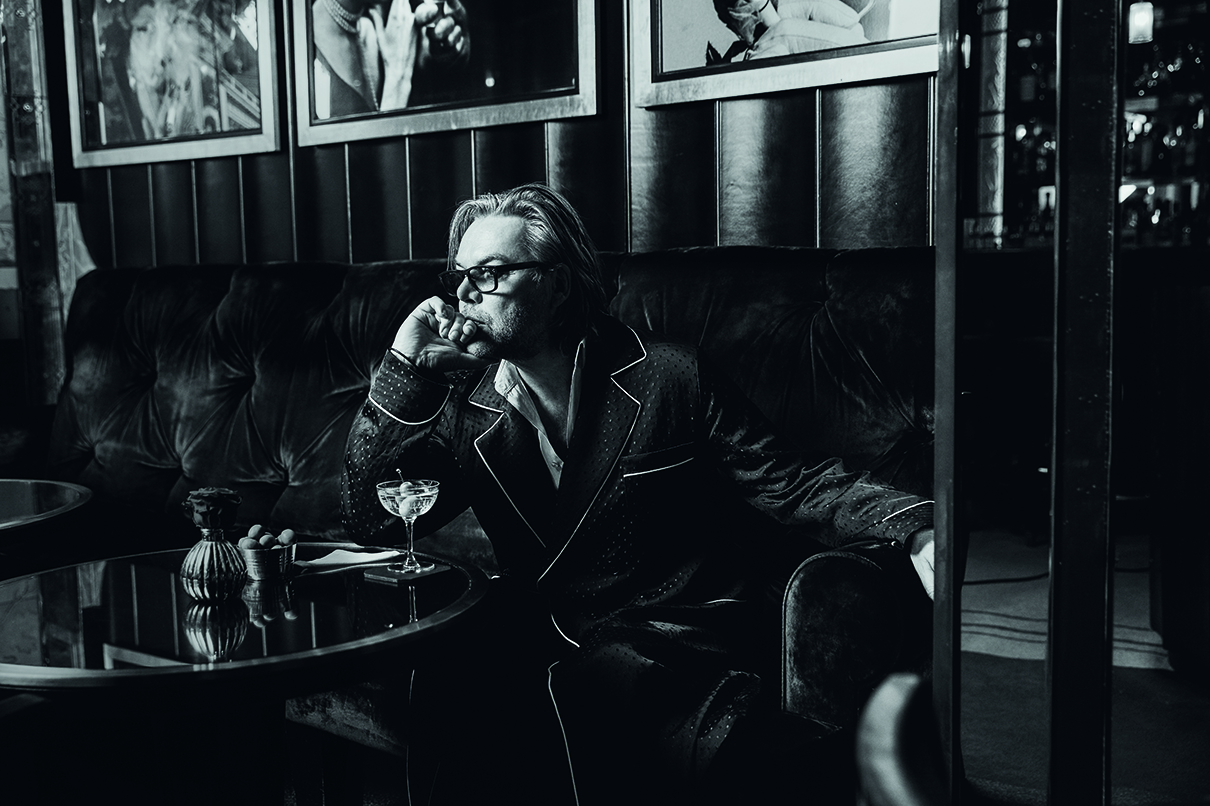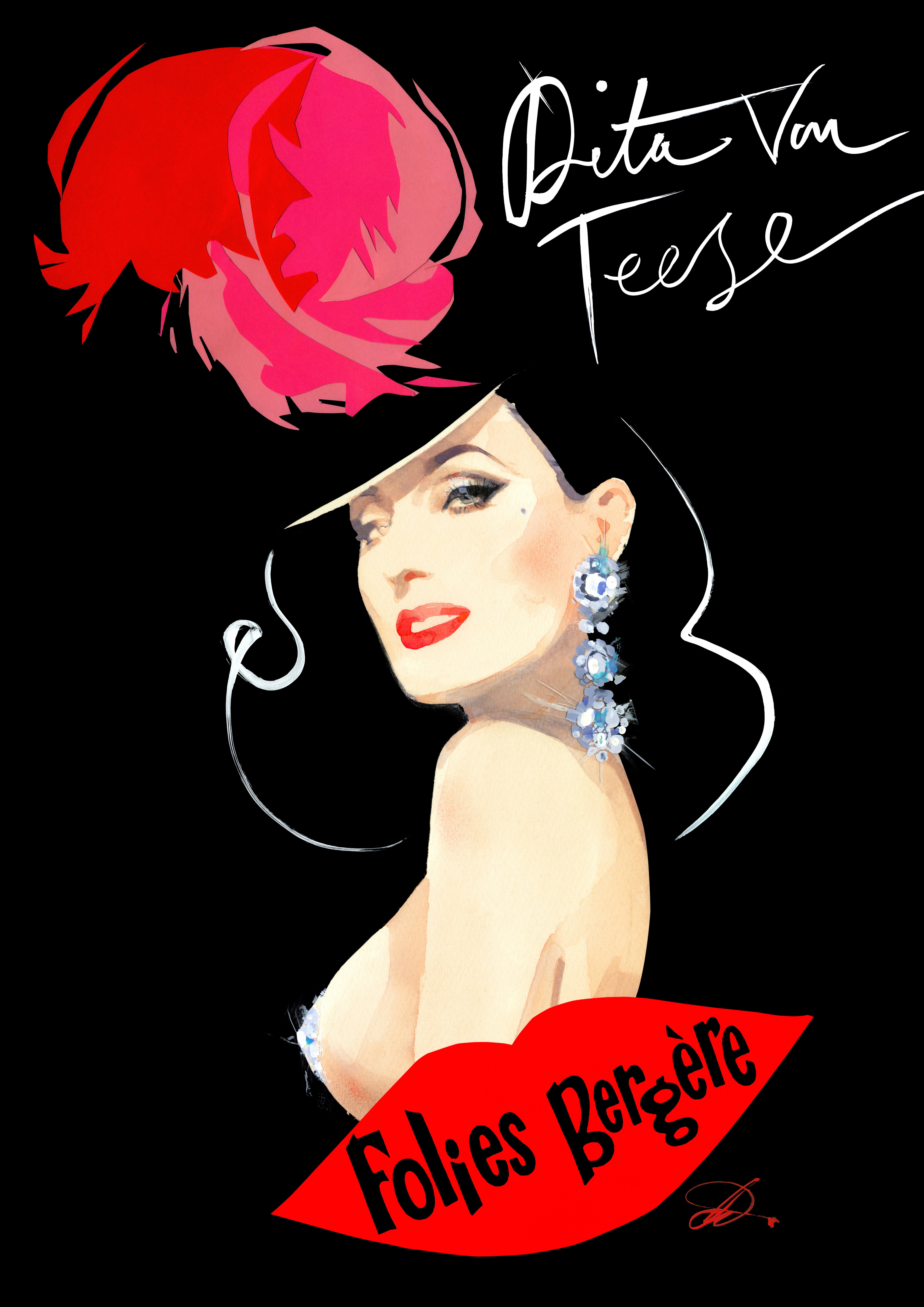David Downton greets me in Claridge’s hotel lobby, where he has been Artist in Residence since 2011. He’s wearing his signature half-tinted glasses and black suit as “DD”, the alter ego that the fashion illustrator created when he became “part of the story”, nearly as well-known as some of the famous women he draws. I follow him down a corridor, lined with his drawings, to ascend to his suite. “They’re running out of space,” he laughs, as I marvel at the extraordinary likenesses he can conjure from just a few, deceptively simple lines. The famous faces include Dame Joan Collins, Christian Louboutin, Erin O’Connor, Michael Kors, Dita Von Teese and many more. “Here’s one hardly anyone recognises,” he says, pausing in front of his drawing of Sir Jony Ive, “despite him formerly being Apple’s hugely influential chief designer.”
David Downton: The Making of a Fashion Artist
13th December 2024
From his suite at Claridge’s hotel, where he’s Artist in Residence, David Downton talks to Charlotte Metcalf about how he became the fashion world’s most sought-after illustrator.


Minutes later, we’re in his suite where he sinks gratefully into a sofa, grins and abandons his alter ego to become David again, the illustrator who penetrated the high-octane world of fashion via a blend of exceptional talent and good luck.
“My family was sporting rather than artistic,” he says, of his upbringing in rural Kent. “My sister was never off a horse, my father played cricket for Kent and my brother, Paul, was England’s youngest wicketkeeper during the 1980s.
“Early on I discovered I had a knack for drawing, and it gave me instant acclaim and gratification. My drawings would be stuck on the fridge for all to see and it was my way of stepping out of my brother’s shadow.”

After an art foundation course at Canterbury, David failed to gain a place at Central School of Art and Design and “sulky and bitter” settled for studying graphics and illustration at Wolverhampton. In 1981 he moved to Stockwell in London and found a job doing market research off Oxford Street in an office next to the teen magazine Look Now. “One day I took in my portfolio and the next I was off,” he laughs.
“I became a freelance moving target, never turning a job down. I wagged my tail when the phone rang. One day I’d be drawing Waitrose’s baguettes or illustrations for how to tie a scarf or pot rosemary, the next it would be historic maps or yoga positions. I even illustrated the 50 top positions for a sex manual. But I loved it all and carried on as I’d achieved my ambition of drawing for a living.”

He was 37 and working for How To Spend It when the art director sent him to Paris to cover Fashion Week. “I’d never been asked to go anywhere on someone else’s money, but the trip changed my life,” he says.
David’s first assignment was sketching a fitting Amber Valetta was having with Valentino in the Ritz. “It was as if I’d walked into a Baz Luhrmann movie, a parallel universe of luxury and beauty where ugliness was not tolerated. I was confronted with a tableau vivant: Valentino’s pugs were everywhere, and Amber was being pinned into a liquid golden dress.” Did he talk to her? “Oh God, no!” he laughs. “Physically perfect people like that might as well be from a different planet.”

Later that evening, he found himself in The Ritz’s basement at the Versace show, with Naomi Campbell, Kate Moss, Christy Turlington and Linda Evangelista strutting their stuff down a marble catwalk built over the swimming pool. He found it extremely challenging to draw such fast-moving figures: “I made manic visual notes in my sketchbook and when I look back at the drawings today, they were pretty awful. I’d done a bit of fashion drawing before, but this was like a novice skier being pushed down a black run. Yet rather than being intimidated, I was exhilarated and hooked on the dramatic, chaotic, surreal environment. There and then I decided I wanted fashion to be the subject of my work.”
He continued doing other jobs while returning to the fashion shows twice a year. Then in 1998, he had an exhibition of his couture drawings, and someone suggested he invite the fashion designer Bruce Oldfield. He brought the supermodel, Marie Helvin, and David asked if he could draw her. “The first drawing wasn’t good, but she was so generous and agreed to a second, which was. She had it made into a postcard and sent it to her friends. She had a radioactive address book so before I knew it, I was drawing Jerry Hall, Iman and Catherine Deneuve.

By 2012, David was enjoying what he terms his ‘Platinum Period’ and working for Vanity Fair. He drew Anjelica Huston, Ali MacGraw, Carolina Herrera, Sofia Coppola, Daphne Guinness and many more. He also drew Carmen Dell’Orefice, now 93, who underlined his firm belief that true beauty has little to do with youthful perfection and everything to do with character: “Conventional prettiness is a great asset in a photograph but a handicap for me, as then I have nothing to draw. Take Paloma Picasso – a feast of angles.”
A party at the Dorchester to launch a book of his drawings followed. “It was one of those lucky nights when everyone was in town. The gods smiled on me,” says David. So starstudded was the event, naturally captured by the paparazzi, that it caught the eye of Paula Fitzherbert, Claridges’s Global Head of Communications, who cooked up the idea of David as Artist in Residence.

Only two sitters have ever disliked his drawings and he’s too discreet to tell me who they are. “On the whole, people are happy to be drawn,” he says. “Famous people are photographed to death, so they’re bored by the process and often know more than the photographer. But with drawing, I know more than them. Also, it involves them being much more low-key than just striking a pose for me to snap. It’s about capturing how I see that person in the hour I have with them. I am not looking to flatter but I am looking for a high point. It is the varnished truth, but it must be true. Famous people are easier to work with than non-famous ones as they’re used to being interpreted and reflected back to. Mere mortals like us might look at ourselves in the mirror once or twice a day, but models and actors are seeing themselves all the time – on screens, posters and in magazines.”
I ask if sitter has ever surprised him and he thinks about it before coming up with Michelle Dockery, whom he drew at the height of her Downton Abbey days. “She was a great mimic and did brilliant, funny impressions,” he recalls.

David then surprises me by saying that during family holidays, he never picks up a pen. “I need a break,” he says. “When I was drawing celebrities and became ‘part of the story’, I had to compartmentalise my life. That’s why I created DD, who is much brasher but frees me from my inhibitions. If I hadn’t created DD with his tinted glasses and fashionable clothes, I’m not sure I’d have survived in the fashion world merely as a greying, ageing geezer.
“Having said that, I love getting old – or older. My flight home from LA for my 65th birthday was cancelled so I decided to go to Las Vegas where Dita Von Teese, whom I’d drawn, was in a show. I ended up celebrating in Vegas with a stripper. How great is that?”

So, what’s next? “A documentary that I can’t discuss, but feel it’s what I’m here for,” he says. “I’m finding ways to be relevant for the next decade.”
He’s drawn his wife and both children, but has he ever drawn himself? “Good God, no!” he says, chuckling. His gift for drawing is prodigious and undisputed, but David – when not being DD – also has a gift for modesty, humour, and being entirely unpretentious. I’ve spent a hugely entertaining couple of hours with him and feel privileged he’s laid aside DD to allow me to meet the real David Downton.






